Washington DC Sep 6 2018(2trip) there is a second part of this trip but it was seeing family.
- alainaa2

- Oct 26, 2018
- 12 min read

3200 Mount Vernon Hwy, Mt
Vernon, VA
22121
Did You Know: This land was originally called "Little Hunting Creek". The name was later changed to "Mount Vernon" after Lawrence Washington (George's older half-brother) was deeded the land. Lawrence had named the land after his former commanding officer, Admiral Edward Vernon was a officer Royal English Navy.
First off I have to say this place is amazing, is truly one of our national treasure, not to be confused with the movie's with the same title. All thou in the second movie a small part was filmed here, and yes they do have a tour that talks about it and you get to go down in the basement/caller off limits to the general public.
Photo Below has the cost and additional tour cost for admission.
Download the app its called George Washington Mount Vernon[I still have mine app].

This was our first time going to Mount Vernon and we thoroughly enjoyed our visit. I have to say that as we get to travel around I am learning so much more than I ever did in history class in school. The things is you do not feel like you are learning and thats the best kind because it is relaxed and fun yes fun.... I love history more out of the class room- nothing like hands on learning.
Gallery from the National Treasure Tour:
This first part was up at the house in the basement/caller of the house that is off limits to the general public highly recommend you take this tour.
The Mansion basement or cellar it was an extremely important part of life in the Mansion. The cellar was used for a variety of purposes and was divided into several rooms. One room, closest to the kitchen, has a large fireplace and was used as a dining area for the housekeeper and other white servants as well as to heat food before it was served to the Washingtons. There were a variety of items stored in the basement such as wine, sand for rustication, and potatoes.
The last part was down at the ice house for the "tunnel part" of the movie. This is of the Movie tour.
Did you know: After Washington's death, Martha Washington closed up the marital bedroom on the second floor and moved to a modest room located on the third floor. and if you visit Mount Vernon during the the period between Thanksgiving and New Year's (usually until January 6th), you can tour the mansion's third floor? It's tight quarters and is only opened for a brief time each year.
Right across from the ice house is the old family crypt but they built a new one and moved them all to it. Martha is right next to her husband in the family crypt. The "old tomb" was the original family crypt, however, in his will Washington designated a new larger burial vault be built and family members were to be moved to the new crypt. This move occurred in 1831. WASHINGTON'S BODY WAS ALMOST BURIED IN THE CAPITOL. Washington requested that he be buried at Mount Vernon, and his family upheld his request, despite repeated pleas by Congress. They wanted to put his body underneath a marble statue in the Capitol.
Did you know: NO ONE WILL EVER RANK HIGHER THAN HIM IN THE U.S. MILITARY. 1976 Washington was posthumously awarded the highest rank in the U.S. military ever. When Washington died, he was a lieutenant general. But as the centuries passed, this three-star rank did not seem commensurate with what he had accomplished. After all, Washington did more than defeat the British in battle. Along the way he established the framework for how American soldiers should organize themselves, how they should behave, and how they should relate to civilian leaders. Almost every big decision he made set a precedent. He was the father of the US military as well as the US itself. So, a law was passed to make Washington the highest ranking U.S. officer of all time: General of the Armies of the United States. Nobody will ever outrank him.
Could not take any photos of inside the house wish I could but so understandable on why not. Trust me so worth going and seeing the inside the house is amazing and worth the trip. If you saw photos it would not do justus. The presidential chair, the trunk Washington carried during the Revolutionary War and the key to the Bastille (a gift from the Marquis de Lafayette) can all be viewed inside Mount Vernon during a tour.
George Washington and the Marquis de Lafayette friendship is extramly important to our history and something Im sad i was never told in US History class.
So cool this tree was planted by President Washington in 1785. later on on doing more research I found out there are several trees from Washington's day still survive on the property's bowling green. These are marked with plaques designating their historic significance. Its like a easter egg hunt.
Did you know: HE WAS WIDELY CRITICIZED IN THE PRESS IN THE LATER YEARS OF HIS PRESIDENCY.He was accused of having an overly monarchical style and was criticized for his declaration of neutrality in overseas conflicts. Thomas Jefferson was among the most critical of Washington in the press, and John Adams recalled that after the Jay Treaty, the presidential mansion “was surrounded by innumerable multitudes, from day to day buzzing, demanding war against England, cursing Washington.”
The exterior of the Mansion is rusticated to look like stone but it is actually made of yellow pine siding.
Rustication is a technique designed to make a wooden house appear to be constructed from stone by beveling the edges of the siding boards to resemble individual blocks of stone. The siding was painted and sand was thrown onto the wet paint, creating a rough stone like texture.
Washington first rusticated the Mansion in 1758 to make it appear constructed of structural sandstone blocks, which were more expensive than wood or even brick. In doing so, Washington preserved the house his father built, while making it appear in the same league with other more substantially built and expensive houses.
The Mansion is not symmetrical, but George Washington wanted it to be.
Before Washington began construction work in 1774, he executed a design drawing showing how he intended the west front of the Mansion to look. The drawing shows the façade as completely symmetrical with the front door and cupola on the center axis, with the windows balanced to either side of it.
But in truth, the door and cupola do not align, nor are the windows symmetrically placed. The construction of the stair in 1758 pushed the door to the north and a window south out of the passage and into the small dining room. This break with architectural ideal is a good example of the value Washington placed on practical solutions to challenging design questions.
Love the little hints of elegance in the curves the hedge in the garden, down to the pleasing symmetric lines in the buildings art is all around us.
Did you know: HE WAS A DOG LOVER.Washington kept and bred many hunting hounds. He is known as the "Father of the American Foxhound," and kept more than 30 of the dogs. According to his journals, three of the hounds' names were Drunkard, Tipler, and Tipsy.
The Bowling green is the area right behind me.
The Bowling Green was an integral part of George Washington’s new landscape plan 1784 and 1787.
While we may be accustomed to such wide expanses of evenly trimmed grass today, in the 18th-century, the broad swath of green would have conveyed a sense of the Washingtons’ wealth, as lawns were expensive to plant and required extensive labor to maintain.
How do you think grass was trimmed in the 18th-century? Enslaved workers leveled the ground with a heavy roller and then cut the grass with a scythe. Maintaining an even surface and uniform height required skill, and only the most experienced enslaved gardeners performed this task.
The Bowling Green was edged with serpentine paths to guide visitors as they meandered through the trees and flowering shrubs on both sides of the open space.
The rest of the photo's and video are from the Museum and Education Center part of the visit.
BEFORE BECOMING THE FATHER OF THE NATION, HE WAS A MASTER SURVEYOR. Washington spent the early part of his career as a professional surveyor. One of the earliest maps he created was of his half-brother Lawrence Washington’s turnip garden. Over the course of his life, Washington created some 199 land surveys. Washington took this skill with him into his role as a military leader.

George Washington wanted to join the Royal Navy, but his mother would not let him.In September 1746, George’s half-brother Lawrence and his friend and mentor Colonel William Fairfax, hatched a plan for the 14 year old that would have him joining a Royal Navy frigate anchored along the Virginia shore as a midshipmen.His mother was convinced that this was not a prudent career move and forbid it. Whether this decision came from reasoned analysis or a desire to retain her eldest son on the Fredericksburg farm, Mary Washington did the American cause a great service in withholding her approval. George Washington learned to be a surveyor at age 16. Instead, he accompanied George William Fairfax as a surveyor to the unexplored wilderness of the Virginia frontier in 1747. The next year, Washington secured an appointment as county surveyor for the newly created frontier county of Culpeper.
Did you know:HE DIDN'T HAVE WOODEN TEETH. He did, however, have teeth problems. When he attended his first inauguration, he only had one tooth left in his head.
Did you Know: HE IS THE ONLY PRESIDENT TO ACTUALLY GO INTO BATTLE WHILE SERVING AS PRESIDENT.HULTON ARCHIVE/GETTY IMAGESBut only if you don't count Bill Pullman in Independence Day. According tothe Alcohol and Tobacco Tax and Trade Bureau, “On September 19, 1794, George Washington became the only sitting U.S. President to personally lead troops in the field when he led the militia on a nearly month-long march west over the Allegheny Mountains to the town of Bedford.”
Did you know: Martha stayed at George Washington’s winter encampments throughout much of the Revolutionary War After Washington left Mount Vernon in 1775, he would not return again for over six years. Every year, during the long winter months when the fighting was at a standstill, the General asked Martha to join him at his winter encampment. Every year she made the arduous journey to his camp, whether it was at Cambridge, Valley Forge, Philadelphia, Morristown, Newburgh, or elsewhere. She stayed with him for months at a time. In fact, during the period from April 1775 until December 1783 Martha was able to be with her husband for almost half the time he was away. The General regarded his wife’s presence as so essential to the cause that he sought reimbursement from Congress for her traveling expenses. Before she could make the first trip, however, Martha had to undergo her own ordeal. She had to be inoculated for smallpox, one of the most deadly enemies soldiers faced during wartime. After successfully weathering the inoculation, Martha could then travel to the soldiers’ camp without fear of contracting the disease or transmitting it to others.
Martha was the Nation’s first First Lady
Just as her husband realized that his actions would set a precedent for future presidents, so Martha, too, was aware that her behavior as first lady would become the template for the wives of future chief executives. One of her most important steps was to initiate a weekly reception, held on Friday evenings, for anyone who would like to attend.
At these gatherings, members of Congress, visiting dignitaries, and men and women from the local community were received at the presidential mansion. After being presented to Mrs. Washington, they enjoyed refreshments, talked with each other, and mingled. Although most guests addressed Martha as “Lady Washington,” some referred to her as “our Lady Presidentess.”

Did you Know: Kidnapping Danger After George became head of the Continental Army during the American Revolution, he had concerns that his position might turn Martha into a kidnapping target: a British ship could sail up the Potomac River at night to grab his wife from Mount Vernon. And he wasn't alone in these thoughts — George's cousin wrote him a letter that noted, "’Tis true many people have made a Stir about Mrs Washingtons [sic] Continuing at Mt Vernon."However, Martha didn't fall prey to the fears that were worrying her husband and others. After all, she knew that she could ride away to escape the British should they get close. Though she would leave Mount Vernon at times in order to live with George in military camps, Martha refused to be chased out of her home because she was scared of the enemy.
Did you know:First Lady Problems After the Revolutionary War, Martha wanted to remain at Mount Vernon, and was disappointed when George became president in 1789. Yet it wasn't until she arrived in New York City, the nation's temporary capital, that she discovered how circumscribed her life as the president's wife was going to be.As advised by Alexander Hamilton and John Adams, George had agreed that the couple would refrain from accepting private invitations. This was done so the president wouldn't be seen as showing favor to certain citizens over others, but the decision cut Martha off from the escape valve of seeing her friends. In the fall of 1789, when George was away, she wrote, "I lead a very dull life here and know nothing that passes in the town. I never go to any publick [sic] place,—indeed I think I am more like a state prisoner than anything else, there is certain bounds set for me which I must not depart from."
Museum and Education Center you can take part in the Interactive Theater: I do not know if the scenarios change or not but there is also a an action adventure movie to see
The Two Worst Days of Martha's Life
Portrait of George Washington (1732–99). (Photo: Gilbert Stuart [Public domain], via Wikimedia Commons)
After George died on December 14, 1799, Martha was so devastated that she couldn't bring herself to step outside for the funeral. The day she lost her husband was, understandably, the saddest of her life. However, what she considered the second most painful day she had to endure is a little more surprising: it was Thomas Jefferson's visit to Mount Vernon in 1801.
This was a terrible event because Martha disliked and disdained Jefferson, sentiments she harbored due to his involvement with political attacks on her beloved husband. As Martha later revealed to a clergyman, she considered Jefferson "one of the most detestable of mankind" and his election to the presidency "the greatest misfortune our country has ever experienced." Basically, if you messed with George, Martha didn't forgive or forget.
Martha freed George Washington’s slaves almost one year after his death
Under the provisions of his will, George Washington declared that the 123 slaves that he owned outright (separate from the dower slaves that would be distributed among the Custis heirs) were to gain their freedom after his wife’s death. There was a fear that these slaves could revolt and kill Martha in order to gain their freedom. Rumors circulated about a suspicious fire at Mount Vernon that may have been set by slaves.
Fearing for her life, Martha, at the urging of relatives, decided to free her deceased husband’s slaves immediately. On January 1, 1801, a bit more than a year after George’s death, Washington’s slaves gained their liberty.
Martha was amazing woman I can't but on here all that I would like this blog is already to long at it is.
Martha Dandridge was born on June 2, 1731 to John and Frances Dandridge, a well-to-do planter family situated in New Kent County, Virginia.
Unlike most women in Virginia in the early 1700s, Martha learned to read and write
Martha married Daniel Parke Custis on May 15, 1750 he passed away on on July 8, 1757, lasted just over seven years.
during that time Martha had four kids but only two servided to when Martha and George got married
(George Washington's Step Children)
Following the death of her first husband, Martha Dandridge Custis was one of the most eligible women in Virginia: young, pretty and very wealthy. It was at this moment that she met George Washington. George had a lot going for him — he was an attractive man with a plantation who had done well during his military service — but he hadn't yet achieved the level of acclaim that would come as a Founding Father.
Yet Martha didn't care whether or not George's status matched hers. After their initial meeting in March 1758, she quickly invited him to visit her again. She had another, wealthier suitor, and given her position wouldn't have had to wait long for more choices, but she liked George. The pair wed on January 6, 1759. It turned out to be a wise decision on both of their parts, as the Washingtons would share a long and happy marriage.
George leading the Continental Army brought him into a position of prominence; as his wife, Martha also became an admired public figure. After visiting Philadelphia in November 1775 (a stop on her way to reunite with George at a military camp), she wrote, "I left it in as great pomp as if I had been a very great somebody."
Martha, who was hailed by many as "Lady Washington," even had a row galley, part of a small Continental fleet, named the Lady Washington in her honor. And when Esther Reed decided to raise money for soldiers, she wanted Martha to be the one to distribute the funds (though George had to step in as his wife was away). Martha would remain in high esteem for the next century, with her image printed on silver dollar certificates in 1886, 1891 and 1896 (making her the last woman to appear on paper currency in the United States — at least until Harriet Tubman shows up on the $20 bill).
Martha’s health, always somewhat precarious, declined precipitously after the passing of George Washington. Just two and a half years after her husband and to the dismay of her extended family, Martha Washington died on May 22, 1802.
Martha’s death brought the Custis heirs even greater riches. Each of Martha’s four grandchildren received substantial amounts of land and money that been held in trust for them for years. Moreover, each received a share of the so-called “dower slaves,” the descendants of the slaves once owned by Martha’s first husband, Daniel Parke Custis. In 1831, after being moved from Mount Vernon’s old tomb to the new tomb, Martha’s remains were placed into a marble sarcophagus that stands near her husband’s at Mount Vernon to this day.
Sorry this blog post is so long like I said I like learning history the hands on way. Hope you learned coming from this page. until nest time
This was a carry on trip




























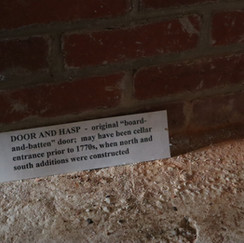





























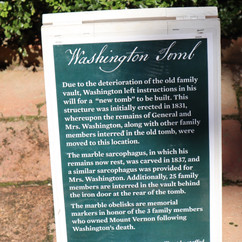























































































































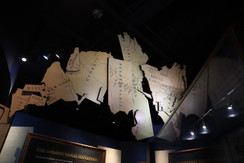







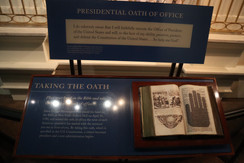











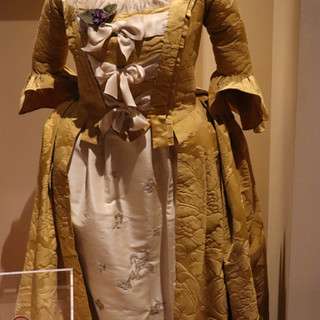










Opmerkingen